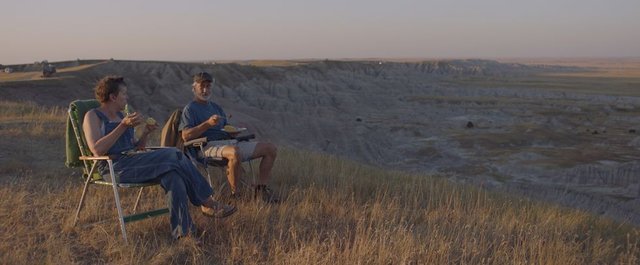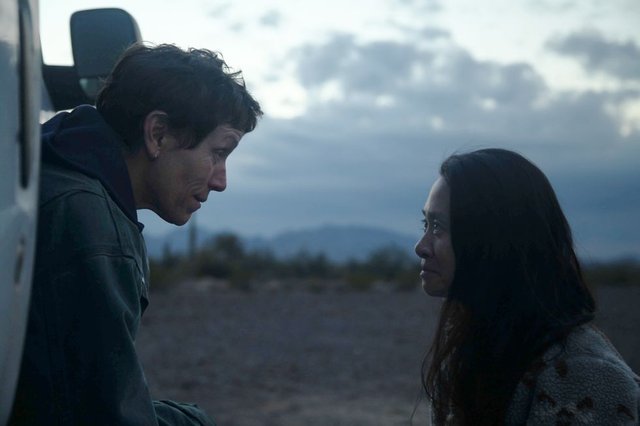Following the economic collapse of her small company town in Nevada, as well as the loss of her husband, Fern (McDormand) packs her dwindling belongings into a van and takes to the road. Adopting a nomadic lifestyle, Fern travels from state to state depending on the seasons (and work opportunities). It isn't an easy path, but Fern soon finds companionship among her fellow nomads, like the welcoming Linda (Linda May, essentially portraying herself) and earnest David (David Strathairn). Fern has lost virtually everything, but she's found a new community in the aftermath.
In terms of a traditional plot, Nomadland doesn't have much to speak of. Instead, Zhao's script adopts a slice of life format where audiences move with Fern through every day beats; they watch her clean out the van (playfully named Vanguard), take on odd jobs, and walk through the various nomadic settlements she ends up in. More than anything, Nomadland actually feels like a documentary. That qualifier might make it sound difficult to become engrossed in Fern's journey, but the opposite is true. Viewers are with her every step of the way, and so each moment in her life somehow feels deeply personal. Even something small, like the breaking of some plates, hits hard as though the person watching was Fern herself.
This is both because of Zhao's gentle direction and McDormand's deeply authentic performance. McDormand's talent cannot be denied at this point; she stands as one of the best actresses of her generation, and Nomadland could very well net her a third Oscar. With just the smallest of gestures, she perfectly conveys everything Fern's feeling, whether it be sadness over leaving her late husband's jacket in a storage locker or joy over realizing she's found her people. She doesn't even have to say anything, because her facial expressions do all the work. In fact, McDormand's performance doesn't even feel like a performance at all, but an extension of McDormand herself. This lends an extra level of authenticity to Nomadland that only enriches the proceedings.
To some degree, “Nomadland” wishes to be settled — wants not necessarily to domesticate its heroine, but at least to bend her journey into a more-or-less predictable arc. At the same time, and in a fine Emersonian spirit, the movie rebels against its own conventional impulses, gravitating toward an idea of experience that is more complicated, more open-ended, more contradictory than what most American movies are willing to permit.
Zhao’s vision of the West includes breathtaking rock formations, ancient forests and wide desert vistas — and also iced-over parking lots, litter-strewn campsites and cavernous, soulless workplaces. Against the backdrop of the Badlands or an Amazon fulfillment center, an individual can shrink down to almost nothing. The nomad existence is at once an acknowledgment of human impermanence and a protest against it.
Fern and her friends are united as much by the experience of loss as by the spirit of adventure. So many of the stories they share are tinged with grief. It’s hard to describe the mixture of sadness, wonder and gratitude that you feel in their company — in Fern’s company, and through her eyes and ears. It’s like discovering a new country, one you may want to visit more than once.
On a friend’s invitation, Fern follows warmer weather to Arizona and attends a gathering of “wheel estate” nomads known as the Rubber Tramp Rendezvous (a real-life annual event featured in Bruder’s book). There, people share food, tools, tips, ideas, and stories. They fix and carry things; they cut each other’s hair. Fern’s path crisscrosses with a few others as they all move around. Shot over six months, the film traces the changing seasons, from a Nebraska beet harvest to a campground in Zhao’s favored part of South Dakota to California’s forests and the Pacific Ocean. There are awkward, grudging encounters, embarrassments, but also moments of lightness and pleasure. Fern dances in a bar, swims naked in a stream, wanders in a vast land-art maze. She meets Dave (David Strathairn), and a somewhat-mutual affection develops. Playing variations on themselves are, among others, a bearded community elder named Bob Wells, who runs the Rendezvous; Linda May, the friend who tells Fern about the gathering, and who plans to build herself a sustainable off-grid dwelling on a small patch of land; and a woman named Swankie, who castigates Fern for being ill-equipped for the conditions, before offering help and comradeship.
These nomads are attuned to the natural beauty they encounter and a sense of joining an American tradition; roaming has become a choice they take pride in, even if a painfully circumscribed one. An obvious danger here is of romanticizing deprivation, as the film balances composing an emotionally satisfying story against chronicling in detail a dark reality. After all, it’s not just the “workampers” who play themselves; the Amazon warehouse does, too. In portraying survivors of a disaster as venturesome heroes, you may risk that flattering light falling on and softening the disaster itself—especially to be avoided with a disaster that, like this one, is not natural but man-made.

